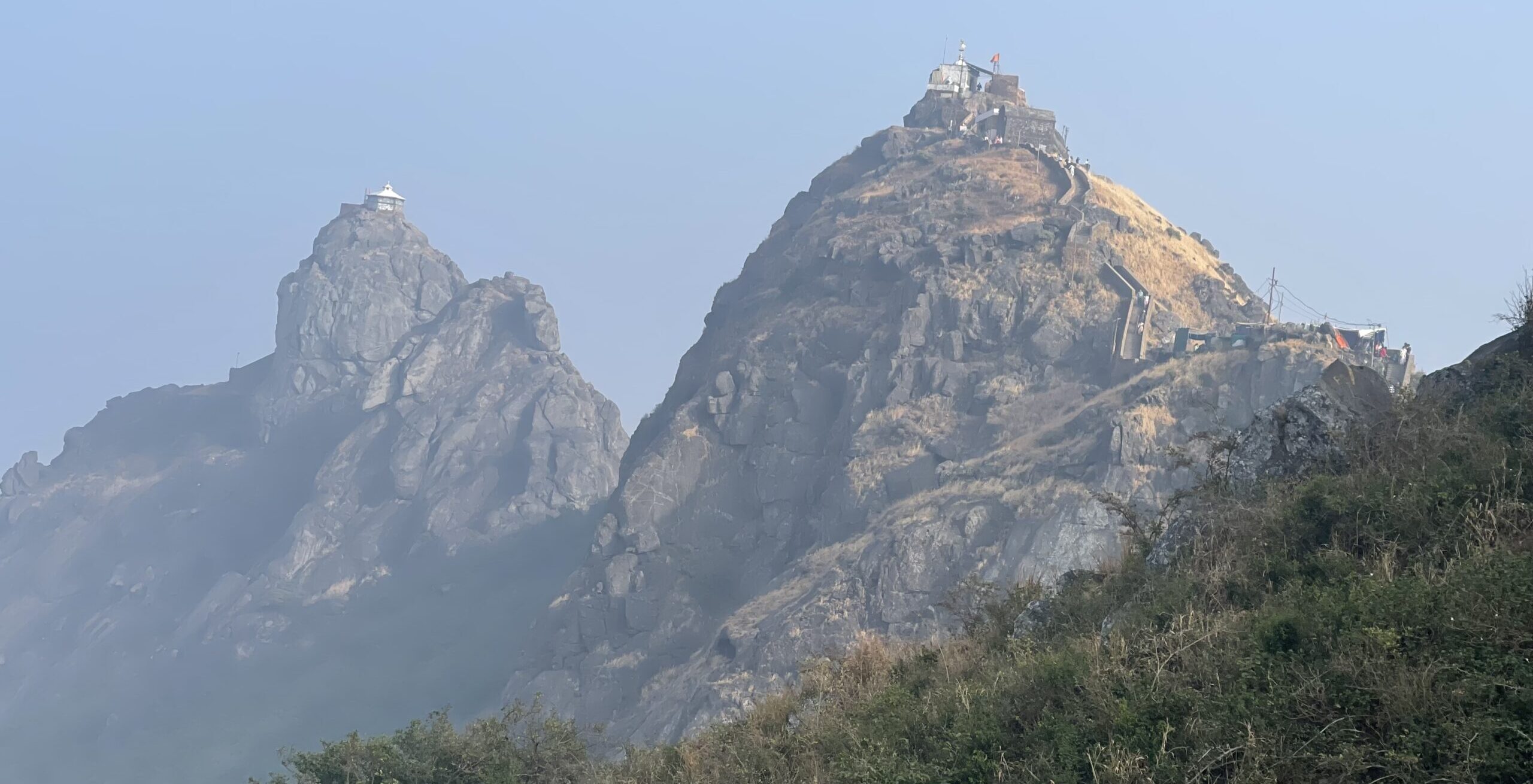🚙 From Hyderabad to Gujarat: Our 10-Day Road Trip Through Time, Culture, and Devotion
A Gujarat road trip is more than just a vacation—it’s a journey through ancient history, divine temples, stunning landscapes, and unforgettable family bonding. In this travelogue, we explore everything from the white desert of Kutch to the sacred temples of Dwarka and Somnath, uncovering hidden gems and spiritual treasures along the way.
My recent family road trip across Gujarat wasn’t just about sightseeing, it was about connecting with the roots of civilization, standing at the edge of international borders, and walking through the footprints of time itself. Buckle up as I take you through our adventure-packed road trip.
Join our unforgettable 10-day road trip from Hyderabad through Gujarat, covering iconic places like Dholavira, Dhordo, Lakhpat, Mandvi, Bhuj, Dwarka, Somnath, Junagadh, and more. Explore culture, temples, festivals, and India’s ancient history through our detailed travel blog.
🚗 Day 1 &2 : Hyderabad to Ahmedabad – The Journey Begins
The adventure began with an ambitious goal, drive nonstop from Hyderabad to Ahmedabad. Yes, you read that right! Fueled by excitement (and lots of snacks), we hit the highway, covering nearly 1,300 km in one go. It was a test of endurance, but also a reminder of how road trips bring families together—through music, laughs, power naps, and roadside chai breaks.
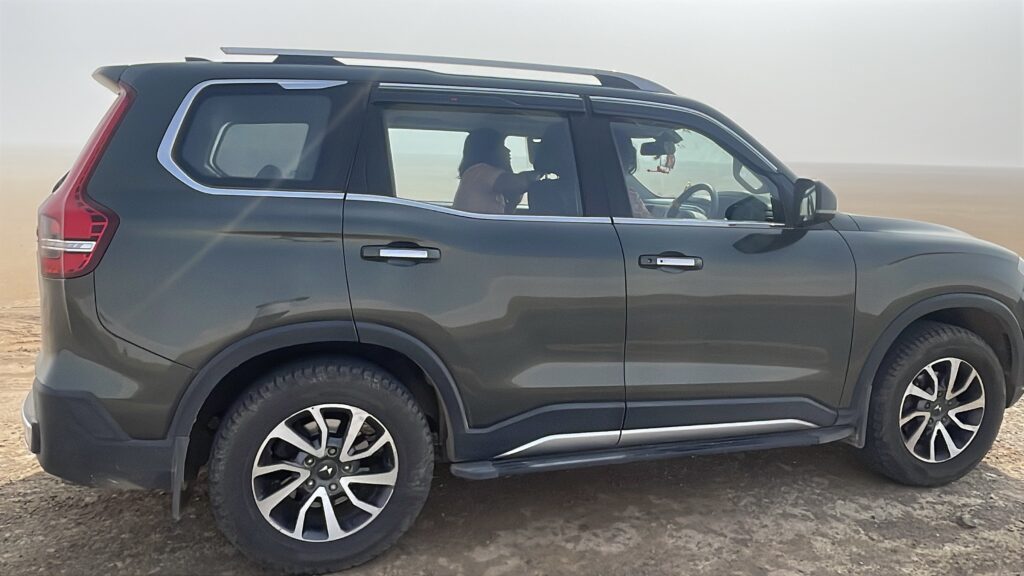
Next day, by the time we reached Ahmedabad around 3 PM after 24 hours drive, we were tired but thrilled, knowing the real adventure was just about to begin. Following our one-hour nap and self-refreshing after hotel check-in, we were prepared to explore Manek Chowk for dinner.
🍽️ Night Delight: Manek Chowk Food Street
After the long journey, there was no better way to reward ourselves than a late-night culinary adventure at Manek Chowk, Ahmedabad’s legendary food street. By day, it’s a bustling jewelry market, but by night, it transforms into a vibrant maze of food stalls serving everything from sizzling pav bhaji to buttery dosas and the cheesiest sandwiches imaginable.
The vibe was electric—families, students, and tourists all gathered under the open sky, enjoying local flavors on plastic chairs and plates. We gorged on buttery pav bhaji, Ghotala Dosa, cheesy sandwiches, and dreamy kulfi along with Jamun shots. A must-visit for food lovers!
After this delicious experience, we took an auto back to the hotel, soaking in the vibrant sights of Ahmedabad—glimpses of the lively Sabarmati Riverfront, bustling streets, and the colorful chaos of traffic. With happy hearts and full bellies, we called it a night.
🌍 Day 3: Nadabet Indo-Pak Border and Nadeshwari Mata Temple
We woke up early in the morning, ready to kick off a long and adventurous day. The plan was to reach Nadabet Indo-Pak border by 9:30 AM, explore the area, and leave by 1 PM to make it to Dholavira in time for a mesmerizing sunset. By 6 AM, we had checked out of the hotel, hit the road in the quiet darkness, and filled up our Scorpio N with fuel along the way. The excitement was real—we had a big day ahead!
Nadabet Indo-Pak Border: Our first sightseeing stop was Nadabet, a lesser-known but deeply moving destination near the Indo-Pak border. Unlike the more popular Atari-Wagah Border, Nadabet offers a raw and authentic experience. The ‘Seema Darshan’ initiative here lets you witness military displays, bunkers, and an up-close look at life in the Border Security Force (BSF).

Private four-wheelers are not allowed beyond a parking area, but buses with permits are available. Of course, VIPs with special permits can take their vehicles all the way to the border without any restrictions.
We bought our tickets—₹100 for adults and ₹50 for kids—which included a bus ride to the border, about 25 km from the main parking area. The ride itself was a treat, passing through the white salt desert, stretches of water bodies, and—if you’re lucky—you might even spot flamingos with their striking pink legs, a true spectacle of the region.
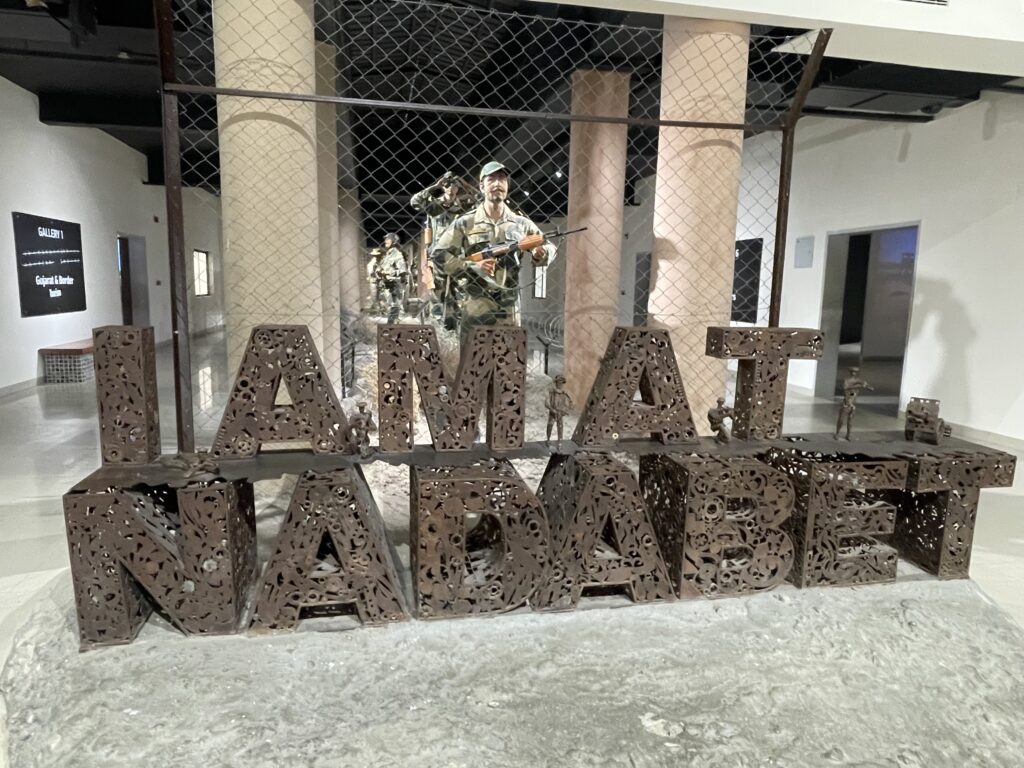
As we reached the border area, surrounded by the tricolor and the echoes of valor, our hearts swelled with pride. An unforgettable experience. Watching the flag ceremony and seeing the tricolor flying proudly just meters away from Pakistan stirred a deep sense of pride.
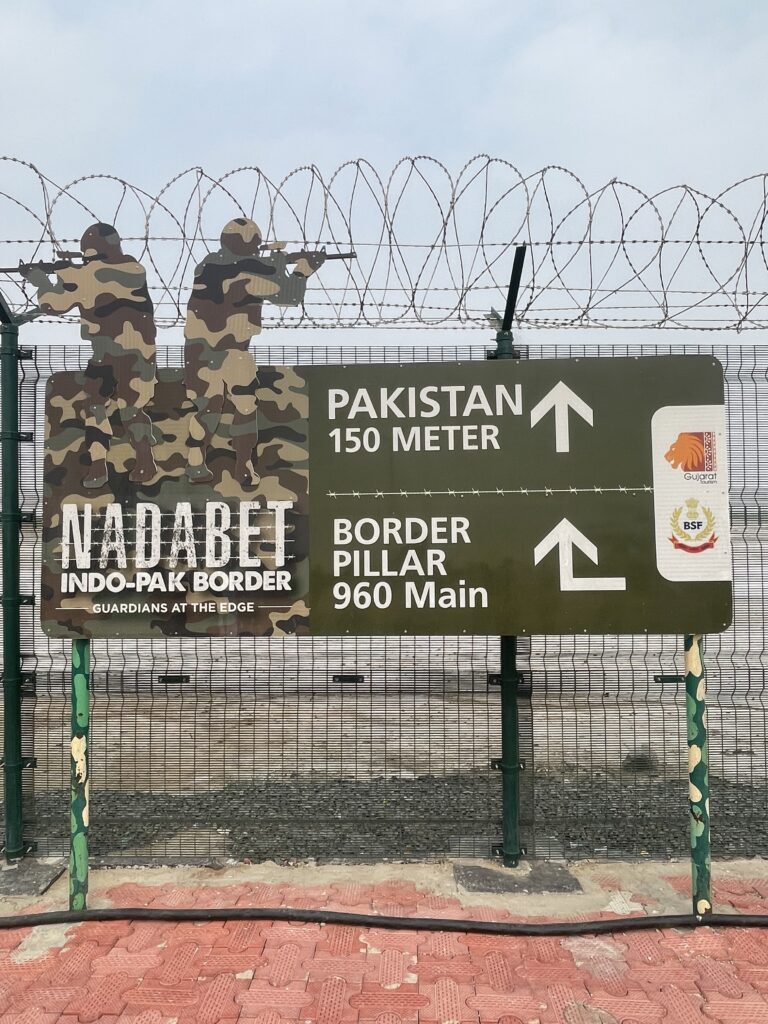
It’s one of those places where you feel your heart swell without even realizing it. It was once a strategic military post during the 1971 Indo-Pak war, now transformed into a patriotic tourist attraction.
Nadeshwari Mata Temple: Just a short drive from Nadabet lies Nadeshwari Mata Temple, a quiet spiritual retreat amidst the stark desert landscape. This temple, dedicated to the guardian deity of warriors and travelers, carries both historical and emotional significance. With its simple architecture and peaceful surroundings, it offered us a moment of reflection after the patriotic high of Nadabet.
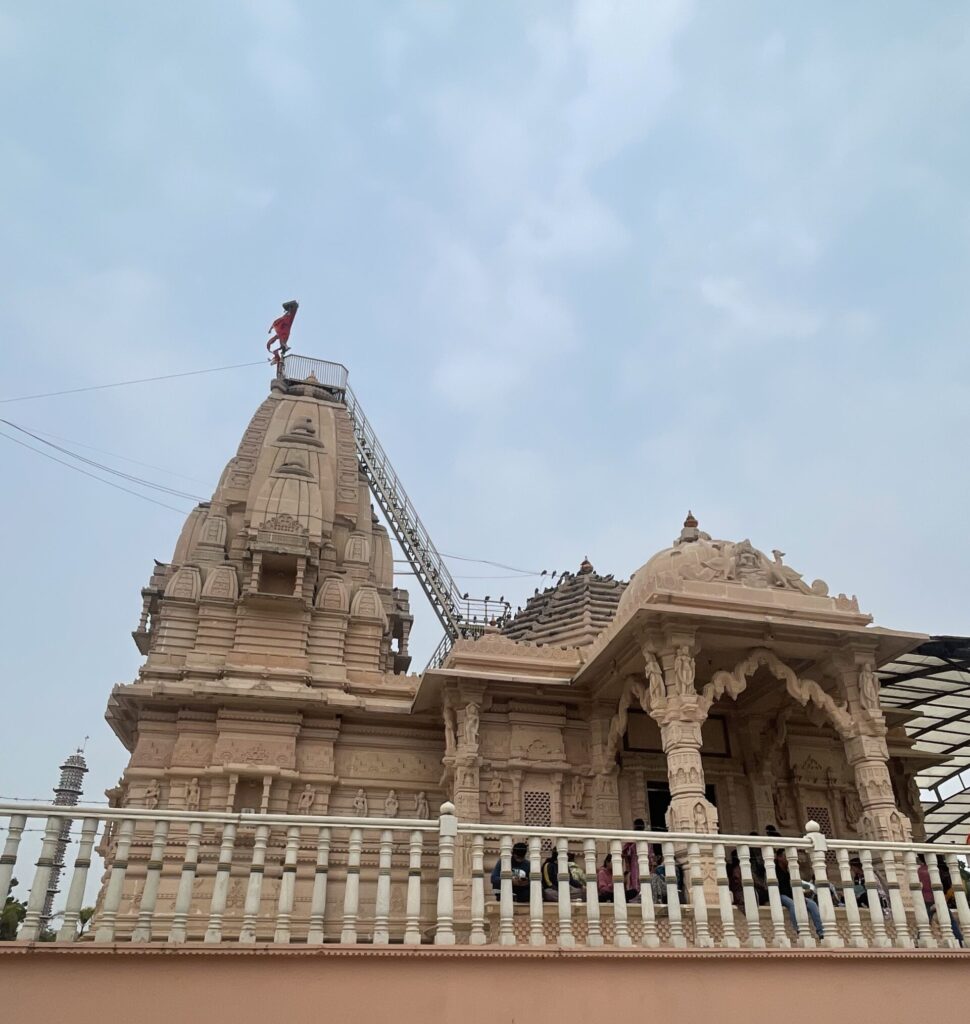
Local lore suggests that the goddess has protected pilgrims and border guards for centuries—a powerful belief that still echoes in the hearts of the people. Peaceful and surrounded by dunes, it’s a spiritual haven. The temple is said to date back centuries and holds deep significance for locals and soldiers alike.
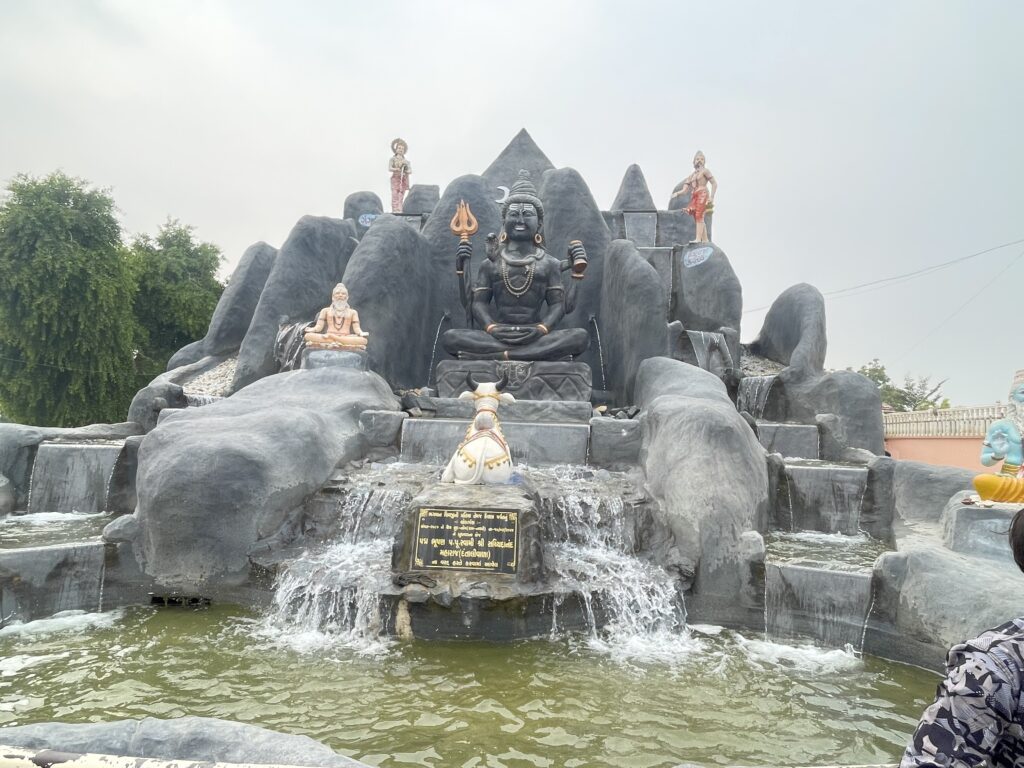
Why visit Nadabet?
-
It’s one of India’s most peaceful border tourism destinations.
-
The Seema Darshan center gives interactive insights into BSF operations.
-
Fewer crowds, more authenticity compared to Atari-Wagah border.
🔺 Day 4: Dholavira – The Harappan Legacy
Dholavira is one of the five largest Harappan sites and the most prominent archaeological site in India belonging to the Indus Valley Civilization. Discovered in 1967, this ancient city showcases advanced town planning, underground drainage, and massive reservoirs—proof of a highly intelligent and organized society from 3000 BCE. It was a hub for trade and maritime connections.
🛏️ Local Stay & Musical Night in Dholavira
After reaching Dholavira, we searched for accommodation and checked with a few resorts—only to find the prices sky-high at ₹7,000 to ₹10,000 per night. After some exploring, we were fortunate to find a budget-friendly traditional Kutchi hut-style resort. The experience was rustic and authentic, complete with a musical night under the stars followed by a hearty dinner.
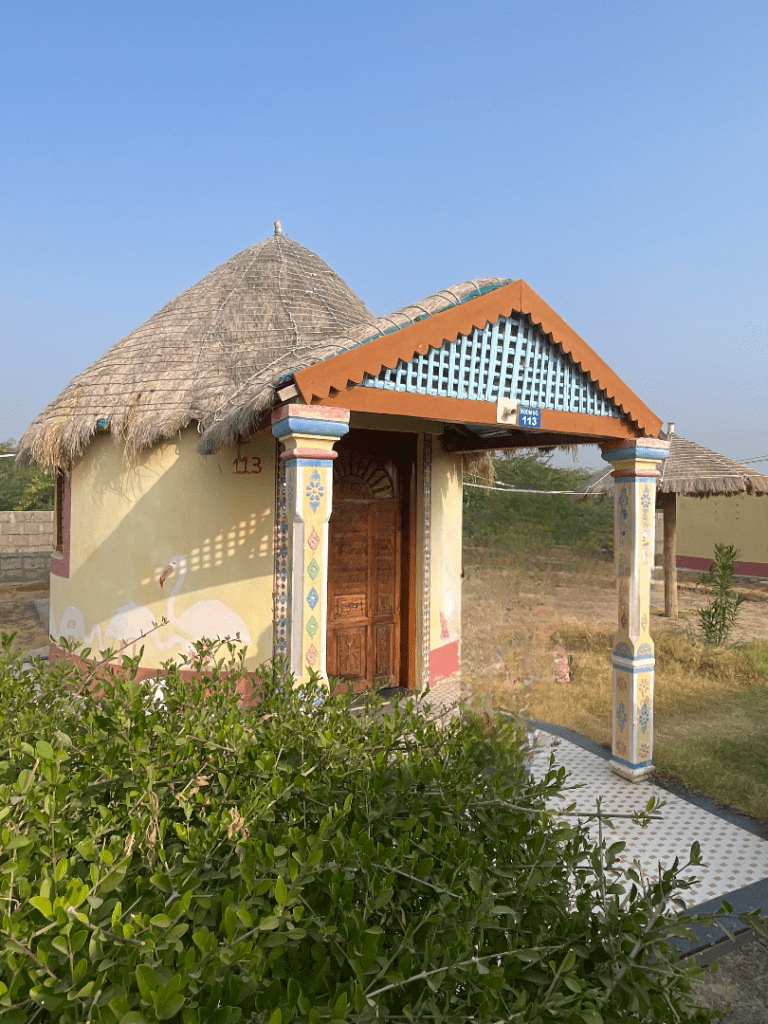
🌅 Sunrise in the White Desert
We woke up early in the dark at 6 AM to catch the sunrise in the White Rann. The Rann of Kutch, the world’s largest salt desert, transformed before our eyes as the sun rose. Shimmering pink, gold, and white hues over the salt flats—this was truly one of the most breathtaking sunrises we’ve ever witnessed.
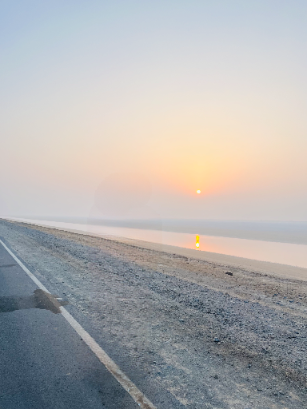
🏛️ Harappan City of Water
Dholavira is a UNESCO World Heritage Site and showcases an incredible urban planning system with a well-structured grid pattern, large streets, and wide roads. The city was divided into the Citadel, the Middle Town, and the Lower Town—each serving specific purposes. As soon as we stepped foot on the site, we were transported back over 5,000 years. Dholavira is one of the most well-preserved settlements of the Indus Valley Civilization, showcasing remarkable feats of engineering like water reservoirs, drainage systems, and urban planning that was ahead of its time.

The city’s highlight is its sophisticated water conservation system, including massive reservoirs, underground channels, and well-planned drainage systems. In a region with scarce rainfall, these innovations allowed the city to flourish.
Among the most fascinating discoveries are inscribed seals with the mysterious Harappan script, monumental gateways, ritualistic platforms, and the remains of workshops. These point to an organized economy, deep spiritual practices, and thriving craftsmanship.
Artifacts like beads, jewelry, pottery, tools, and even burial sites speak of a complex society that existed over 5,000 years ago.
Walking along stone paths, peeking into ancient wells, and standing by the signboards carved in the mysterious Harappan script which is still not decoded by anyone—it was a surreal reminder of how advanced our ancestors truly were. Dholavira isn’t just ruins; it’s a silent city whispering stories of a civilization that once thrived where now only wind and time roam freely.

What makes Dholavira special?
-
Advanced water management systems
-
Urban planning and large reservoirs
-
Inscriptions in Harappan script
🦕 Dholavira Fossil Park
Our next stop was the Fossil Park near Dholavira, and trust me, it felt like stepping into a natural history museum carved right into the Earth. The park features fossils of ancient trees and marine life dating back hundreds of millions of years, long before humans walked this land. Some of the fossils are over 180 million years old, bearing witness to an era when the Rann was a shallow sea.
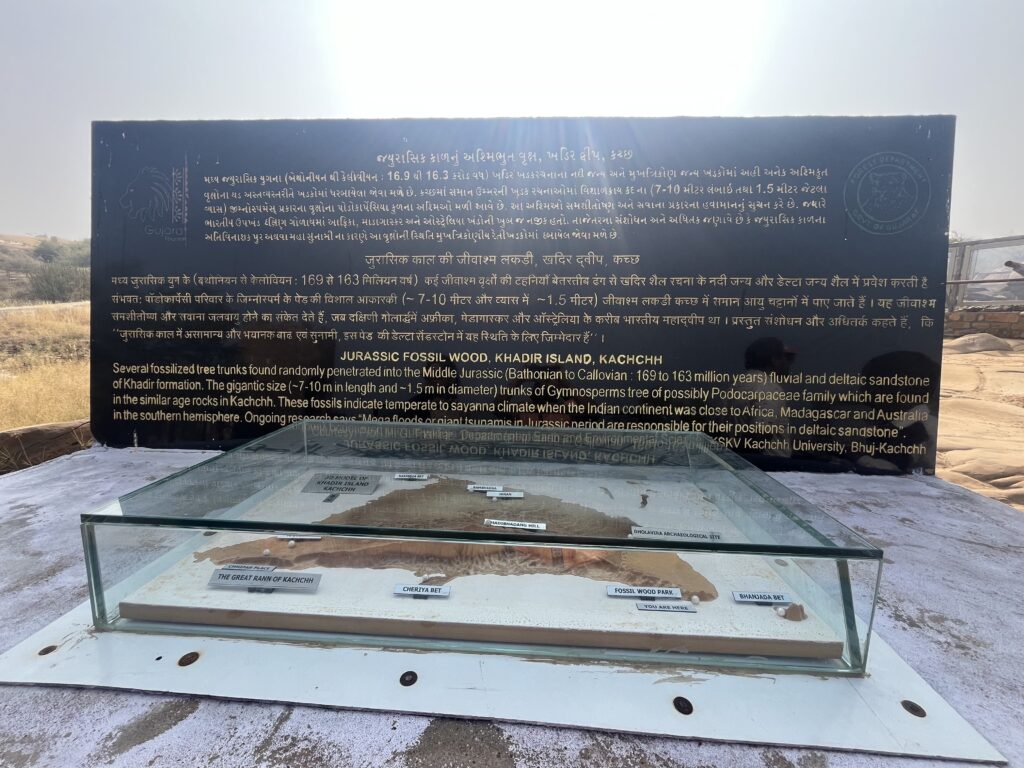
It was humbling to run our hands over the fossilized remains of trees that once stood tall before even the concept of civilization existed. For nature lovers and curious minds, this park is an absolute treasure. Now, it was time to start for our next destination which was Dhordo where there is a festival going on which is called “Rann of Kutch” festival.
🛤️ The Road to Heaven
On our way from Dholavira to Dhordo, we drove through a surreal stretch known as The Road to Heaven. This breathtaking route, surrounded by the vast salt desert of the White Rann, gave us an optical illusion where the road appeared to float in the sky. It felt like we were driving into a dream as the barren land stretched endlessly beneath the clear blue sky. The experience was both peaceful and humbling, providing stunning views and photo opportunities that left us in awe of the natural beauty of Gujarat.
🏞️ Kalo Dhordo – The Black Hill
Our visit to Kalo Dhordo was nothing short of enchanting. As we arrived, we were greeted by the striking Black Hill, a formation of dark basalt rock that stands in stark contrast to the vast white desert. At the base of the hill, we visited the Dattatreya Temple, a serene and peaceful spot dedicated to the Hindu trinity of Brahma, Vishnu, and Shiva. The temple’s tranquil atmosphere offered a moment of spiritual reflection amidst the arid landscape.
We then began the climb up the hill via steep steps to enjoy a 360-degree panoramic view of the surrounding area. The hilltop offered breathtaking views of the endless desert landscape dotted with small hills and the Rann, which seemed to stretch on forever. For those who may not be able to climb the hill, camel rides are available, offering an alternative way to explore this unique spot.
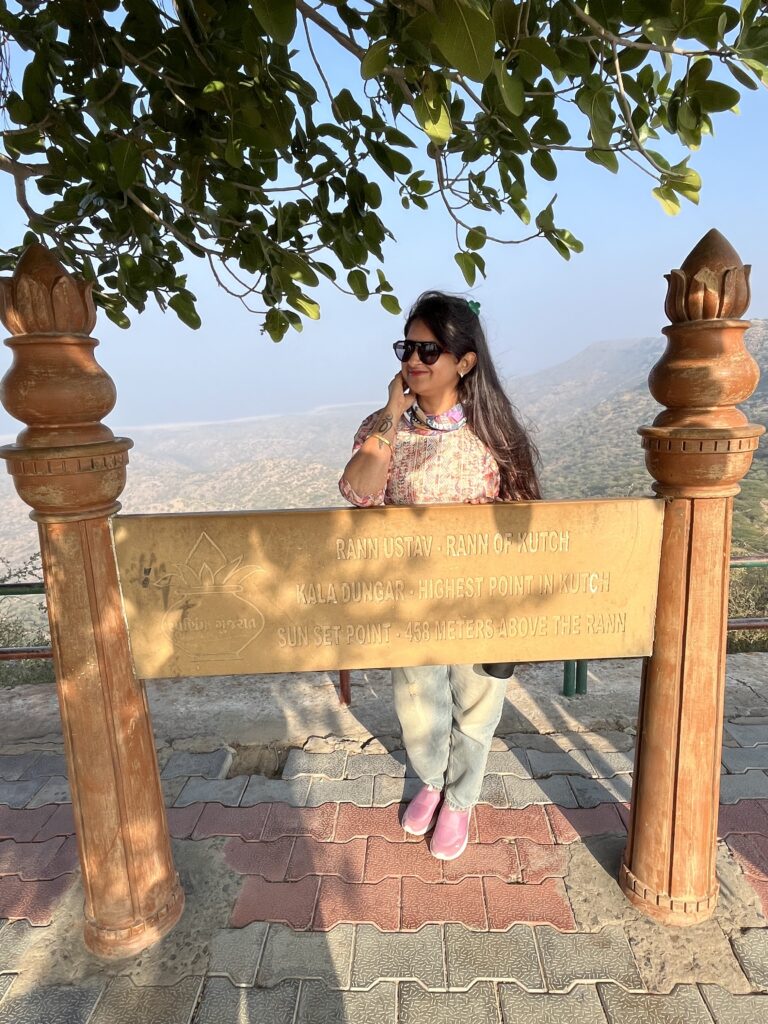
For photography lovers, Kalo Dhordo is a paradise. The combination of the dramatic landscape and traditional Kutchhi attire makes for incredible photo opportunities. We even donned the traditional Kutchhi pagdi (turban) and local dress, capturing many memories with our friends and family. The vibrant colors of the attire against the stark backdrop of the desert created perfect photo moments, giving us lifelong memories.
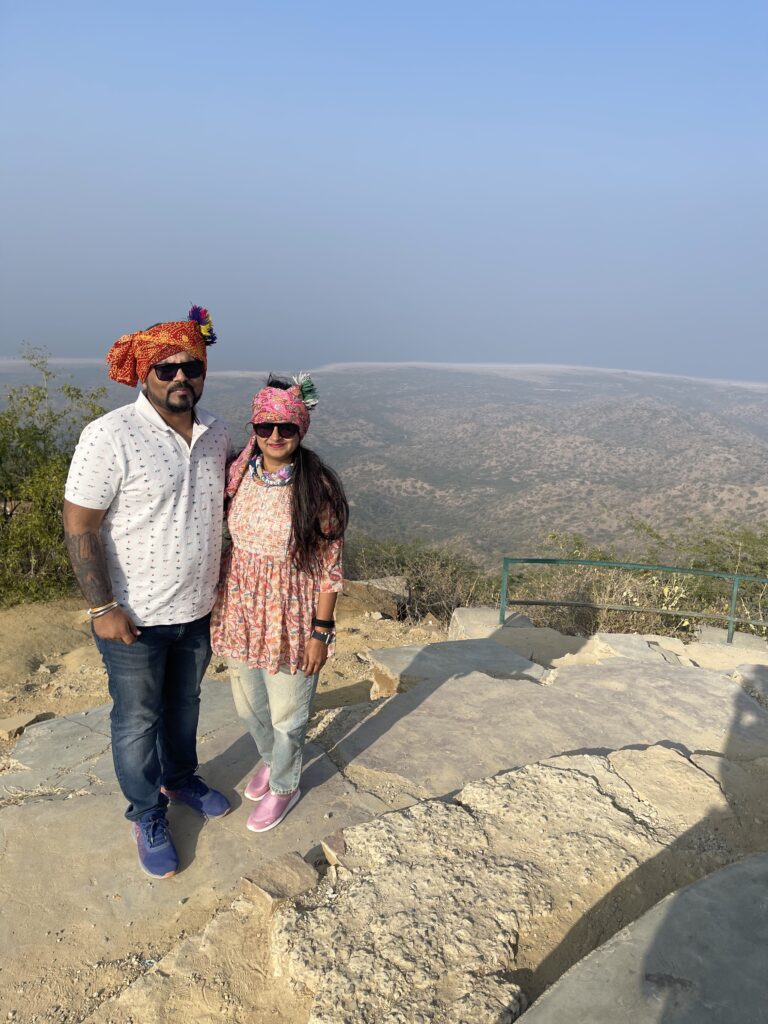
As the clock neared 4 PM, we began our descent from Kalo Dhordo, eager to reach Dhordo in time for the mesmerizing sunset in the White Desert. However, something unusual caught our attention on the way down—the Magnetic Hill phenomenon. It’s a place where vehicles seemingly defy gravity and move uphill even when switched off. At first, we were skeptical, but curiosity got the best of us.
To our surprise, as we stopped the car on the marked spot and turned off the engine, our ScorpioN slowly started moving uphill on its own! It was a strange but fascinating experience that left us in awe, especially since we weren’t alone—many other visitors were also experiencing the same phenomenon and laughing in disbelief.
Afterward, we sped towards Dhordo, hoping to catch the last rays of the sun over the white sands. Upon arriving, we checked out a few of the tent accommodations available, but the prices were quite steep. After some searching, we finally found a tent resort within our budget. Relieved and excited, we paid a token amount to secure our stay.
🌅 Sunset in the White Desert
With the accommodation sorted, we rushed to obtain the permit to enter the White Desert. There’s a large parking facility at the Rann Utsav, but the permit counter process was slow, taking almost 20-30 minutes. The counter staff were quite slow in issuing permits, which added to our time. I’d recommend securing your permit online before visiting, as this could save a lot of time.
Once we had our permit, it was time to board the hop-on hop-off bus service that takes you into the White Desert, as private vehicles aren’t allowed inside. Unfortunately, by the time we reached the desert, the sun had already set. Initially, I felt a bit disappointed, as I had hoped to witness the sunset in its full glory, but we made the most of the situation.
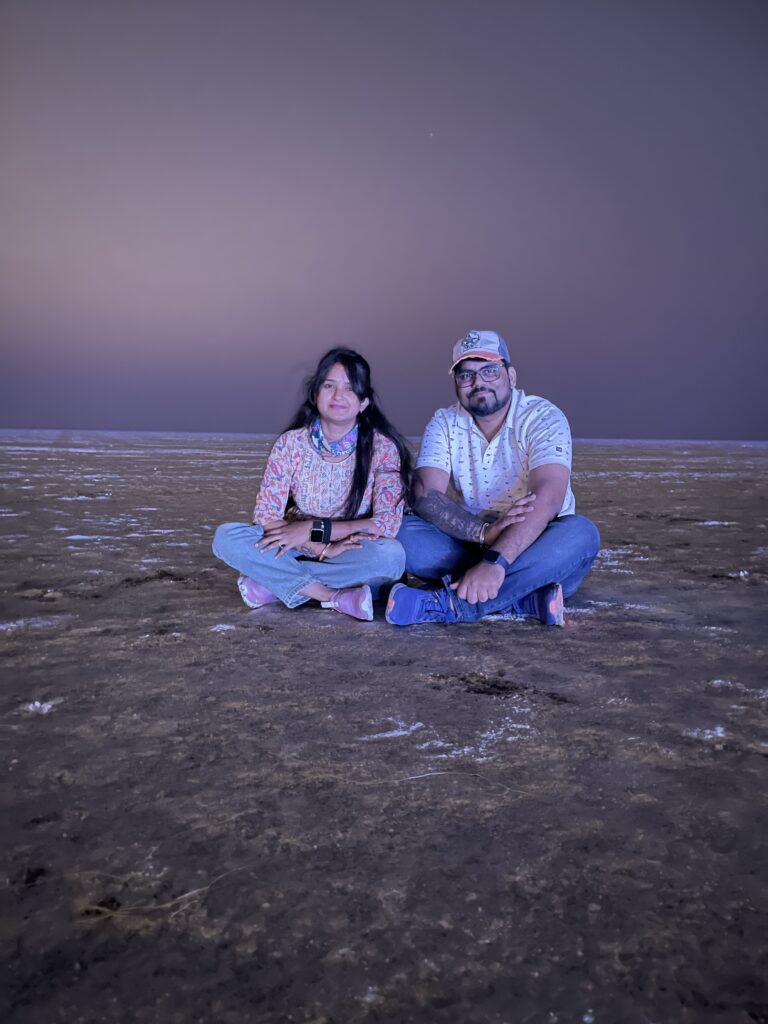
We decided to take a peaceful walk through the salt desert, where the vastness of the landscape and the tranquility helped lift our spirits. Even though the sunset had passed, the unique atmosphere of the Rann, with its endless white expanse under the fading twilight, was still mesmerizing.
After our time in the White Desert, we returned to our tent resort, filled with memories of the day. We rested for a bit and then enjoyed a hearty local dinner. To make the night even more special, we were treated to a traditional musical performance, where local artists played instruments and sang folk songs that celebrated the culture of Kutch. The music was a perfect end to an unforgettable day.
🛕 Day 5: Morning Journey to Ashapura Mata Temple
The next morning, we bid farewell to the vibrant atmosphere of Dhordo and headed towards the Ashapura Mata Temple, a place we had heard so much about but missed during our last visit two years ago. It was a long-awaited stop, and we were eager to experience its divine energy.
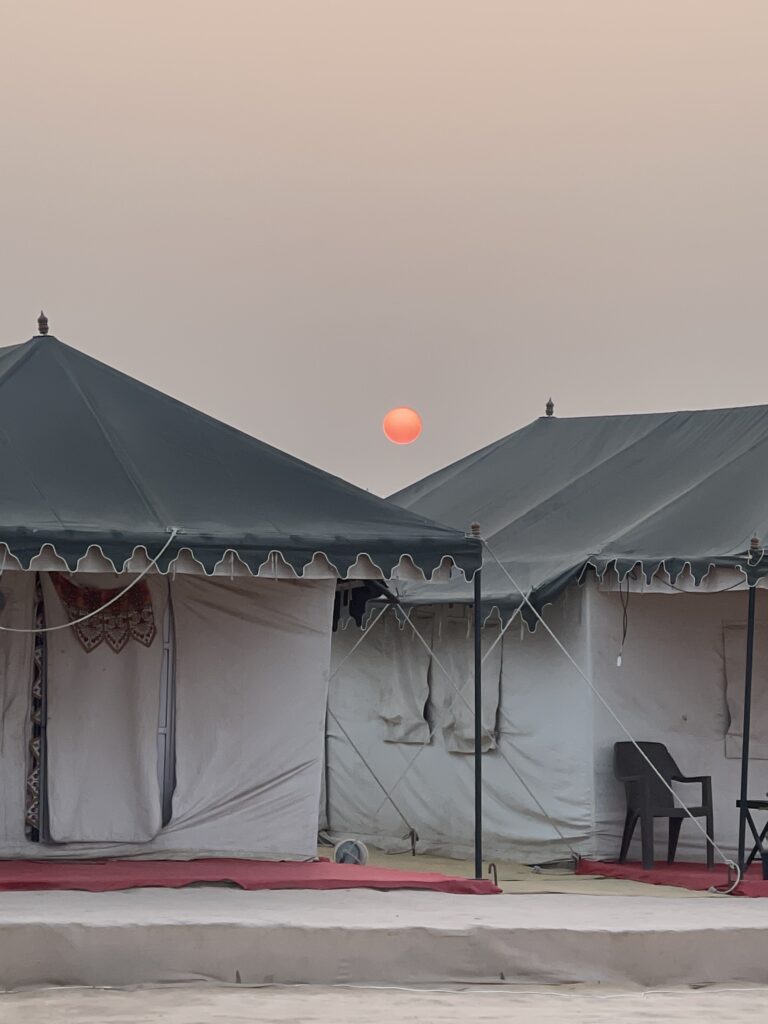
The road to the temple was about 2 hours long, but the journey itself was an experience to remember. As we drove through the stunning Kutch landscape, we were treated to breathtaking views of vast fields, winding roads, and distant hills. The serene surroundings set the perfect tone for our visit to this revered spiritual site.
Located in the heart of the Kutch region, the Ashapura Mata Temple is dedicated to Ashapura Mata, the goddess revered as the protector of Kutch. For centuries, this temple has been an important pilgrimage site for devotees, particularly for the Kutchis, who believe that the goddess brings blessings of prosperity, peace, and protection. The temple’s serene and peaceful surroundings make it an ideal spot for spiritual reflection and connection.
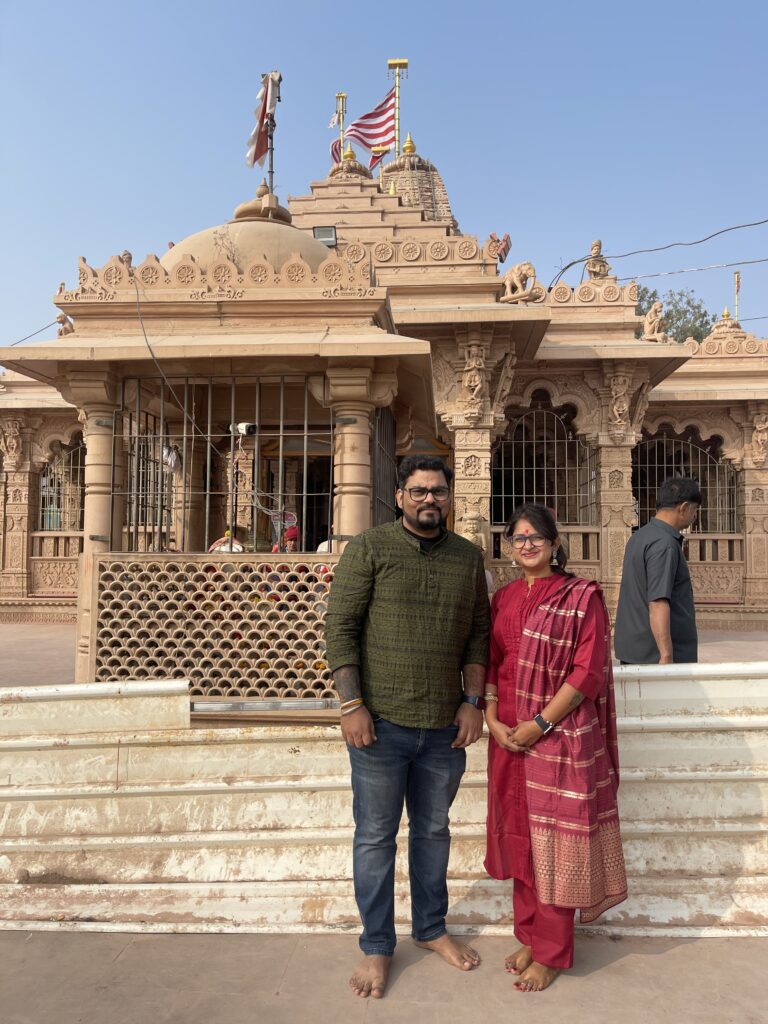
We were struck by the temple’s architectural beauty and tranquil atmosphere, making it a must-visit for anyone seeking a deep connection with the divine and a glimpse into the rich cultural heritage of Kutch. The visit was peaceful, and we could feel the aura of devotion as we offered our prayers.
Next, we visited the Khatla Bhavani Temple, another sacred site with deep spiritual roots in the Kutch region. This temple, dedicated to Goddess Bhavani, is believed to offer divine protection and blessings to its visitors. The peaceful atmosphere inside the temple encourages meditation and introspection, allowing visitors to find inner peace and strength.
🏰 Exploring Lakhpat Fort: A Glimpse Into Gujarat’s Rich History
After visiting Ashapura Mata Temple, we continued our journey towards Lakhpat, where we encountered a place that is often overlooked by most travelers—Lakhpat Fort. This remote site in Gujarat offers a unique and peaceful experience, allowing visitors to step back in time.
Lakhpat Fort was once a thriving port town and a strategic location in Gujarat’s trade network. Built by the Kutch rulers to protect the region from invasions, the fort’s imposing ramparts, ancient gates, and watchtowers stand as silent witnesses to centuries of history.

Lakhpat holds significance beyond its military importance. The fort complex houses a Gurudwara, dedicated to Guru Nanak Dev Ji, marking the visit of the revered Sikh Guru to the region. This adds an interesting spiritual dimension to the site, reflecting Gujarat’s rich cultural and religious diversity. In addition to the Gurudwara, there are also temples and mosques scattered across the fort, offering a beautiful blend of architectural styles.
The journey to the fort is a peaceful one, with stunning views of the white desert that stretch as far as the eye can see. The sense of history is palpable, and the atmosphere is perfect for reflection and photography.
Gurudwara Pehli Patshahi, located within the fort, commemorates the visit of Guru Nanak Dev Ji on his journey to Mecca. It’s a serene place with white domes and spiritual tranquility, welcoming people from all faiths. For those who love history, architecture, or discovering hidden gems in India, Lakhpat Fort is a must-visit destination!
🌊 Narayan Sarovar & Koteshwar Mahadev Temple: Spiritual Tranquility at the Edge of India
After our visit to Lakhpat Fort, we headed towards Narayan Sarovar and Koteshwar Mahadev Temple, two significant spiritual destinations nestled in the heart of Gujarat.
Narayan Sarovar: Narayan Sarovar is one of the five sacred lakes in Hinduism, often referred to as Pancha Tirth. Pilgrims believe that taking a dip in its holy waters purifies the soul and grants divine blessings. As we arrived, the temples were closed but would open around 3:30-4 PM, giving us some time to explore. We spent time by the serene lake, offering our prayers and soaking in the peaceful atmosphere.
The surroundings of Narayan Sarovar are beautiful, with lush landscapes and ancient temples adding to the spiritual ambiance. It’s a place of great significance in Hinduism, attracting devotees from across the world, especially during festivals.
Koteshwar Mahadev Temple: Just 1 km away from Narayan Sarovar, we made our way to Koteshwar Mahadev Temple, dedicated to Lord Shiva. This temple, situated at the westernmost tip of India, offers breathtaking views of the Arabian Sea. The temple’s significance stems not only from its age but also from the divine energy it radiates. Pilgrims visit this ancient site to seek Lord Shiva’s blessings and connect with the spiritual atmosphere of the place.
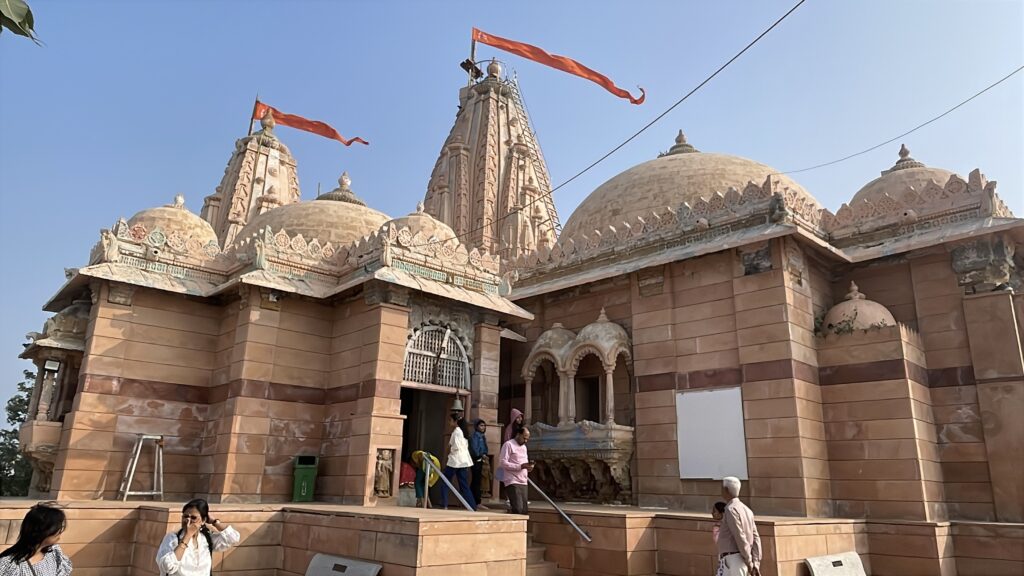
The BSF post near Koteshwar marks the last point of the Indian mainland, adding an extra layer of intrigue to this already powerful location. The views from the temple are mesmerizing, and the peaceful ambiance made it a perfect spot for reflection.
Both Narayan Sarovar and Koteshwar Mahadev Temple are not just religious landmarks but are deeply embedded in the local culture and hold immense significance for devotees. Whether you’re seeking spiritual solace or admiring the natural beauty of the area, these destinations are truly a must-visit when in Gujarat.
🌅 Final Stop at Mandvi: A Peaceful End to the Day
After our visit to Koteshwar Mahadev Temple, we returned to Narayan Sarovar, as the temple had reopened. We were fortunate to have an amazing darshan of Shri Vishnu and other divine forms at the temple. The serene ambiance and the deep spiritual energy of the place left us feeling rejuvenated.
It was now time to head towards our final destination for the day — Mandvi, a beautiful beach town on the coast of Gujarat. We had planned to stay there for the night and then continue our journey to Bhuj the next day.
However, by the time we reached Mandvi, I was not feeling well. I had developed a fever, and my temperature was rising, so I had to take some medicine to rest. Despite not feeling my best, we checked into a hotel near the beach and decided to take a peaceful walk along the shore in the evening.
The cool sea breeze and the sound of waves helped me unwind, even though I wasn’t feeling great. After our walk, we returned to the hotel, had a simple but satisfying dinner, and closed the day, grateful for all the beautiful experiences we had, despite the physical discomfort.
🌊 Day 6: Morning in Mandvi & Journey to Bhuj
The morning in Mandvi didn’t feel much better due to fever, and for a moment, I thought of staying back to rest. However, I decided to continue our journey to Bhuj. After taking a refreshing bath to prepare for the day, we checked out from the hotel and set off for Swaminarayan Beach.
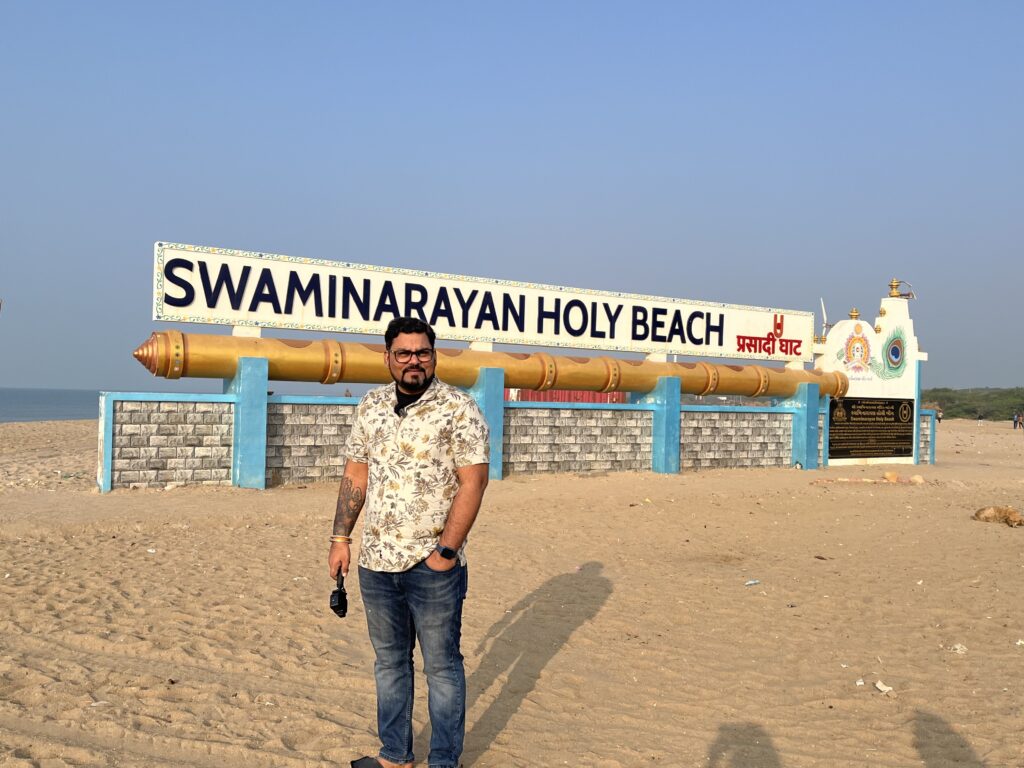
The beach was quite windy, and there were a lot of birds in the area, adding to the serene atmosphere. One notable feature of the beach is a huge flute-like structure, which made for a perfect photo opportunity. We spent some time there, capturing memories with photos before beginning the drive to Bhuj.
🏛️ Smriti Van Earthquake Memorial Museum – A Tribute to Resilience
The scenic drive from Mandvi to Bhuj was peaceful, and it didn’t take long to reach our next destination — the Smriti Van Earthquake Memorial Museum.
The Smriti Van Earthquake Memorial Museum stands as a powerful tribute to the victims of the 2001 Gujarat earthquake, which caused immense devastation in the region. The museum, located in Bhuj, not only commemorates the lives lost in the tragedy but also celebrates the strength and resilience of the people who endured and rebuilt their lives after the disaster.

What makes the museum even more significant is the message of hope and recovery that it conveys. The memorial park and its surroundings are not just a reminder of a devastating tragedy but also a symbol of the remarkable resilience of the people of Kutch and Bhuj.
Visitors can see the different exhibits showcasing the impact of the earthquake, the lives it disrupted, and the transformation that followed. It’s a somber yet uplifting experience — a place for reflection, remembrance, and understanding the strength of communities in the face of adversity.
🚗 How We Reached Kadiya Dhro: The Ultimate Off-Road Experience
After visiting the incredible Smriti Van Earthquake Memorial Museum, we decided to take a detour to Kadiya Dhro, a location not marked by conventional roads — and that’s exactly what makes it so exciting.
From the main highway, Kadiya Dhro is about 5–6 km of raw trail through bushes, sand, and dense thickets. Locals offer a jeep ride for ₹1000, but since we were in our 4×4 Scorpio-N SUV, we went full throttle off-road!
⚠️ Note: If you’re not confident with off-road driving or traveling solo, it’s safer to take the local jeep service. With multiple narrow trails, it’s easy to get lost.
🪨 What Makes Kadiya Dhro So Special?
✅ Unexplored Beauty
Kadiya Dhro remains largely untouched by commercial tourism. You’ll find yourself surrounded by raw landscapes, unique rock formations, and a calm silence that’s rare in today’s travel destinations.
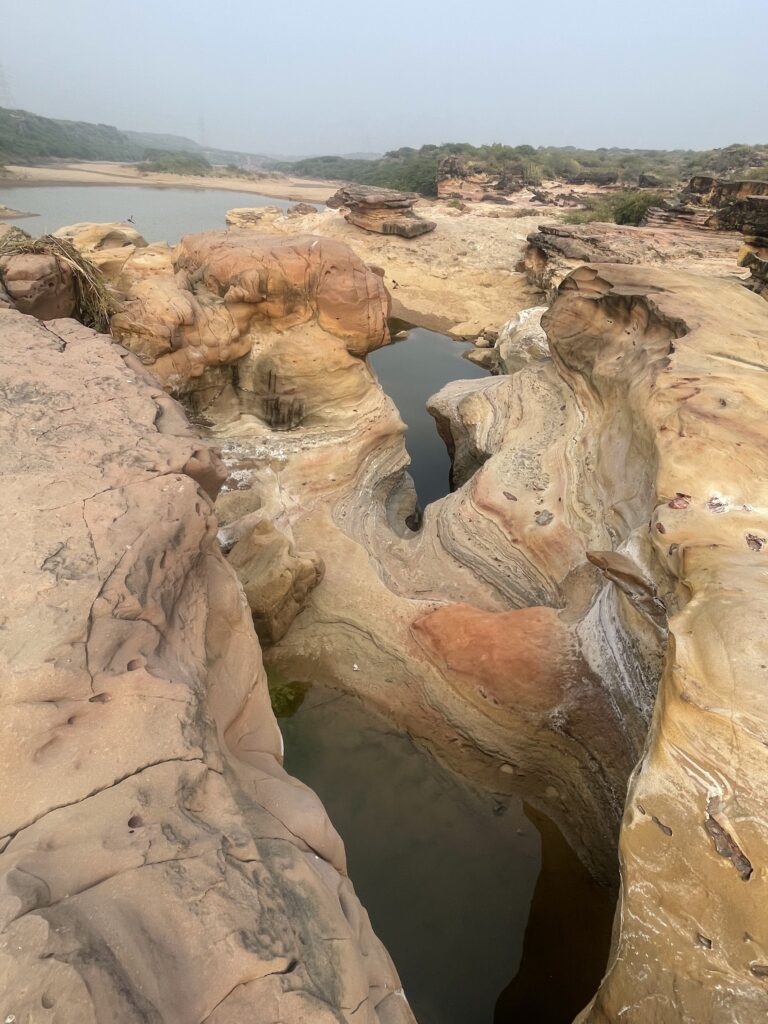
🕳️ Ancient Caves
The area is also home to historic caves that hold spiritual and cultural significance. Though not heavily documented, these caves whisper stories of ancient times and local legends.
🌳 Tranquil Vibes
Nature lovers will fall in love with the peaceful ambiance. You can stroll along quiet paths, enjoy scenic photo ops, or just sit on a rock and breathe in the stillness of Gujarat’s wilderness.
🧳 Tips for Visiting Kadiya Dhro
-
✅ Travel in a 4×4 vehicle or hire a local jeep
-
✅ Carry ample water, snacks, and a GPS-enabled phone
-
✅ Start your trip early to enjoy sunlight and safe return
-
✅ Wear comfortable shoes – some climbing may be involved
-
❌ Don’t go alone – it’s remote, and trails can be confusing
Kadiya Dhro isn’t just a destination — it’s an experience. If you love the thrill of discovering lesser-known places with rich history and surreal nature, this is your place.
🛕 Swaminarayan Temple, Bhuj: A Spiritual Pause on Our Road Trip
After the thrilling off-road adventure to Kadiya Dhro, we made our way to the Swaminarayan Temple in Bhuj, one of the city’s most peaceful and spiritually uplifting landmarks.
When we reached, the temple gates were closed for a short while. We waited patiently, and soon enough, the doors opened for the evening Aarti. The serenity of the temple, combined with the soulful chants during Aarti, was a perfect way to unwind and feel connected after a long day on the road.
🏨 Hotel Hunting Late at Night in Bhuj
Post-darshan, it was already getting late, and we needed a place to crash for the night. As always, I began checking multiple hotels — but almost every place was fully booked. I even considered heading towards the highway to try our luck at some roadside motels.
But just when things started to feel uncertain, luck smiled on us. We found a hotel in Bhuj city — it was slightly on the expensive side, but with the clock ticking past 10:30 PM and everyone completely drained from the day’s adventures, comfort won over cost. I didn’t think twice. We booked the room immediately.
We checked in, and without wasting a minute, hit the bed for some much-needed rest. The day had been long, exciting, and full of surprises — just the kind of journey we live for.
🛣️ Pro tip: Always try to book your hotel by evening in tourist-heavy areas like Bhuj, especially during the festive or travel season. Last-minute availability can be tough to find!
🚙 Day 7: Bhuj to Dwarka – A Divine Call from Shri Krishna
The next morning, we woke up at 4 AM, freshened up, and prepared to continue our journey — this time toward Dwarka, though we weren’t completely sure if we’d go. But something inside felt like a divine nudge from Shri Krishna himself, guiding us to seek his darshan. Without overthinking, we hit the road.
The drive from Bhuj to Dwarka took about 6 hours, and as we approached the holy town, the time was around 12:30 PM — just as the main Dwarkadheesh Temple closed for its midday break. Since the temple would reopen around 4:30-5 PM, we decided to make the most of the waiting time.
🕉️ Exploring the Sacred Around Dwarka
1️⃣ Shri Nageshwar Mahadev Jyotirlinga
Our first stop was the Nageshwar Jyotirlinga, one of the 12 sacred Jyotirlingas dedicated to Lord Shiva. The energy here was intense, and the darshan took us about an hour.
2️⃣ Rukmini Devi Temple
Next, we visited the temple of Devi Rukmini, the beloved wife of Lord Krishna. The temple’s peaceful vibes are interwoven with legend — due to a curse from Sage Durvasa, Devi Rukmini had to live away from Krishna, and this shrine honors her eternal devotion.
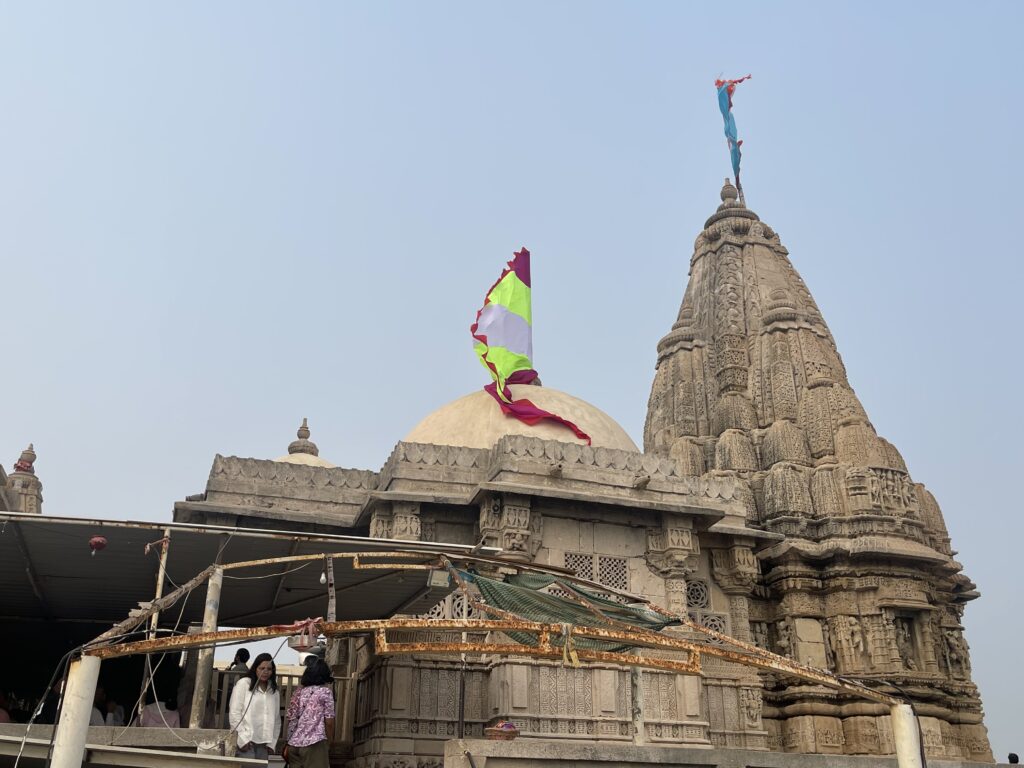
3️⃣ Bhadkeshwar Mahadev Temple
Then we made our way to the stunning Bhadkeshwar Mahadev Temple, perched near the beach. This temple is believed to be over 5000 years old, dating back to the Mahabharata era, and offers breathtaking views and spiritual calm.
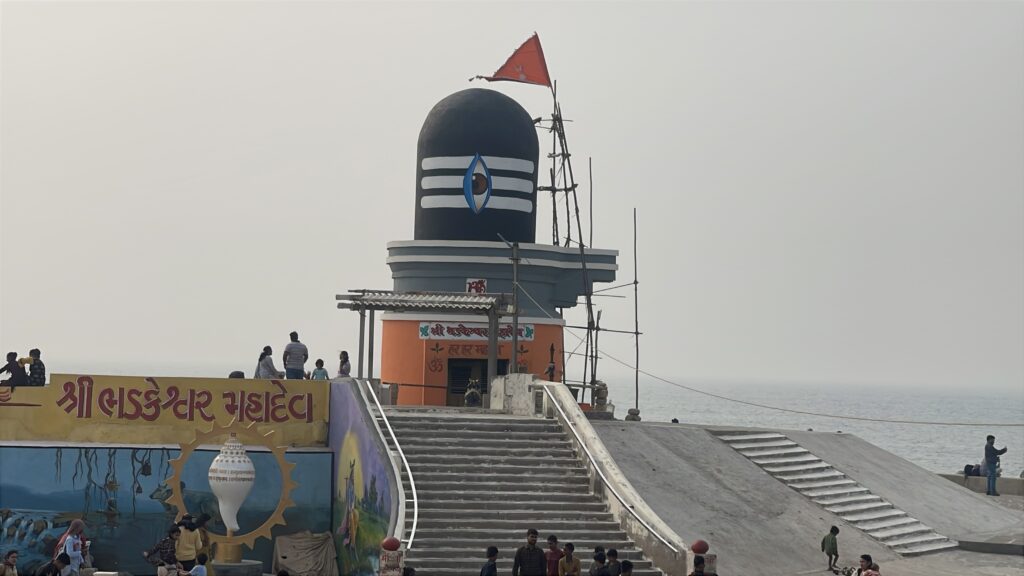
🛕 Shri Dwarkadheesh Darshan
By evening, it was time for the main event — darshan at Dwarkadheesh Temple, the heart of Dwarka. We parked our trusty ScorpioN in a secure parking (₹100), and walked through colorful, vibrant market lanes buzzing with pilgrims.
The temple was packed with devotees, and we waited patiently in line for nearly an hour. The moment we stood before Shri Dwarkadheesh Bhagwan, it felt like all our wishes had come true. The feeling was indescribable — peace, joy, and gratitude all wrapped into one divine moment.
After the darshan, we visited Gomti Ghat and Sudama Setu, both just next to the temple — a serene end to our Dwarka chapter.
🚗 Dwarka to Somnath – A Midnight Spiritual Sprint
Just when we thought of staying overnight in Dwarka, a sudden wave of motivation hit — why not head straight to Somnath and have darshan at another Jyotirlinga Temple?
We began the 150 km drive at full throttle, determined to reach before the temple closed. By 10 PM, we made it to Somnath — just 5 minutes before the closing! We ran inside and got divine darshan of Mahadev at Shri Somnath Temple, the first Jyotirlinga in India. Though we missed the prasad, the satisfaction of making it in time was unmatched.
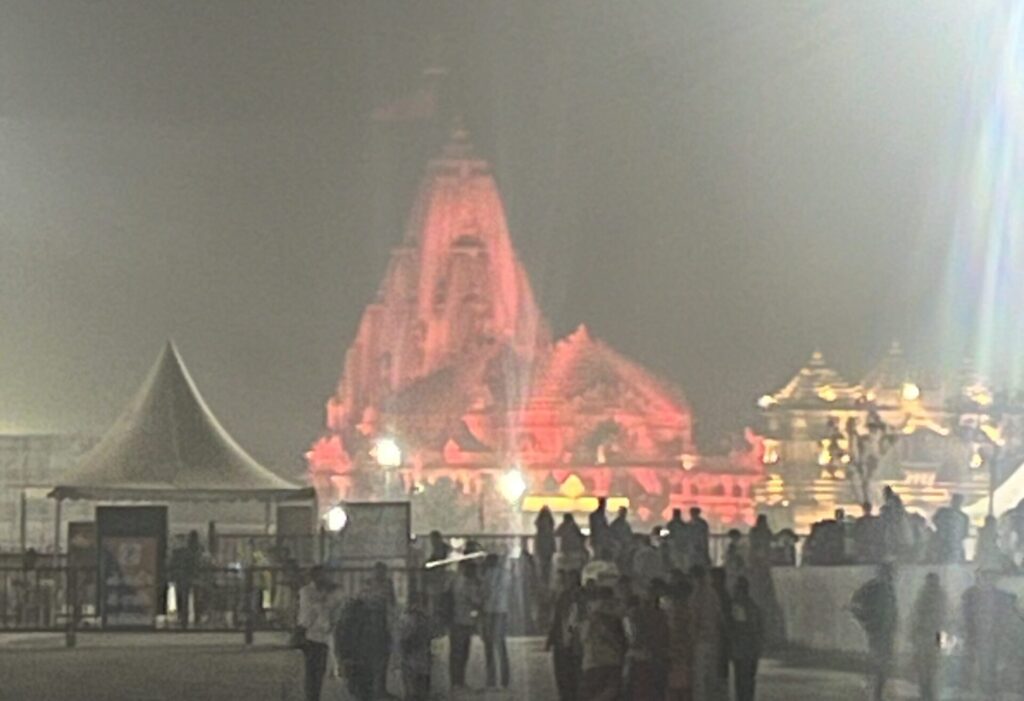
🍽️ Late Dinner and the Hotel Hustle
After the temple visit, we had dinner at the famous Madhav Restaurant, known for its authentic Kathiyawadi thali — delicious and soul-satisfying after a long day!
But then came the real challenge: finding a place to sleep.
We checked over 10 hotels, and all were fully booked. We were exhausted and running low on patience. Some local agents approached us, offering rooms — but the places they showed were poorly maintained, smelly, and unhygienic, yet asking for ₹5000–₹8000 per night. It felt like clear exploitation of tired families with no options left.
🚐 Sleeping in the ScorpioN at Somnath
Frustrated but not defeated, we returned to the Somnath Temple parking lot — spacious, clean, and with toilet facilities. We parked our ScorpioN around 12:30 AM and decided to sleep in the car.
It was chilly outside, so we could safely turn off the engine and sleep comfortably. The parking area had constant movement of vehicles, so it felt safe and secure throughout the night.
🌙 It wasn’t the comfiest night, but sometimes, these raw travel moments become unforgettable memories. From divine darshans to sleeping under the stars — this was a day to remember.
🌄 Day 8: Somnath to Girnar – A Day of Devotion, Ropeways, and Unexpected Turns
After a cold but safe night in the Somnath Temple parking lot, we woke up around 7:30 AM, still curled up in the comfort of our ScorpioN. It took us a good 30 minutes to get moving — the kind of slow, lazy morning you get after a whirlwind day.
We freshened up, brushed our teeth, and headed back to the Somnath Temple for a peaceful morning darshan. The temple was less crowded at this hour, and in just 15-20 minutes, we were standing once again in front of Mahadev, offering our gratitude and receiving prasad.
🕉️ The Legacy of Devi Ahilyabai Holkar
Next, we visited the temple built by Devi Ahilyabai Holkar, the legendary queen and a devoted follower of Lord Shiva. She is known for restoring and building numerous temples across India, and this one stood as a testimony to her dedication.
However, the crowd was intense this time — it took us nearly 1.5 hours to complete our darshan. Still, it was worth it, knowing the historical and spiritual significance of the place.
🌊 Triveni Sangam and a Change of Plan
After returning to the parking area, we drove to the Triveni Sangam, where three rivers — Hiran, Kapila, and Saraswati — meet the Arabian Sea. We spent about 20 minutes soaking in the serenity of this spiritual confluence.
We then considered going for a Gir Forest Safari, but the charges were quite high, and we were running low on budget for such an experience. So, we quickly shifted plans and set off for Junagadh, aiming to trek or take the ropeway to Girnar Parvat — a long-standing wish.
🏔️ Girnar Parvat – A Spiritual Ascent
We reached the base of Girnar Parvat, where there are two options to reach the top:
-
10000 steps
-
Or the Udan Khatola ropeway, which costs ₹700 per person
Though climbing 10,000 steps would’ve been epic, we were exhausted, so we opted for the ropeway — a stunning 8-9 minute ride over green hills, dense forests, and hundreds of Jain temples perched on the mountain.
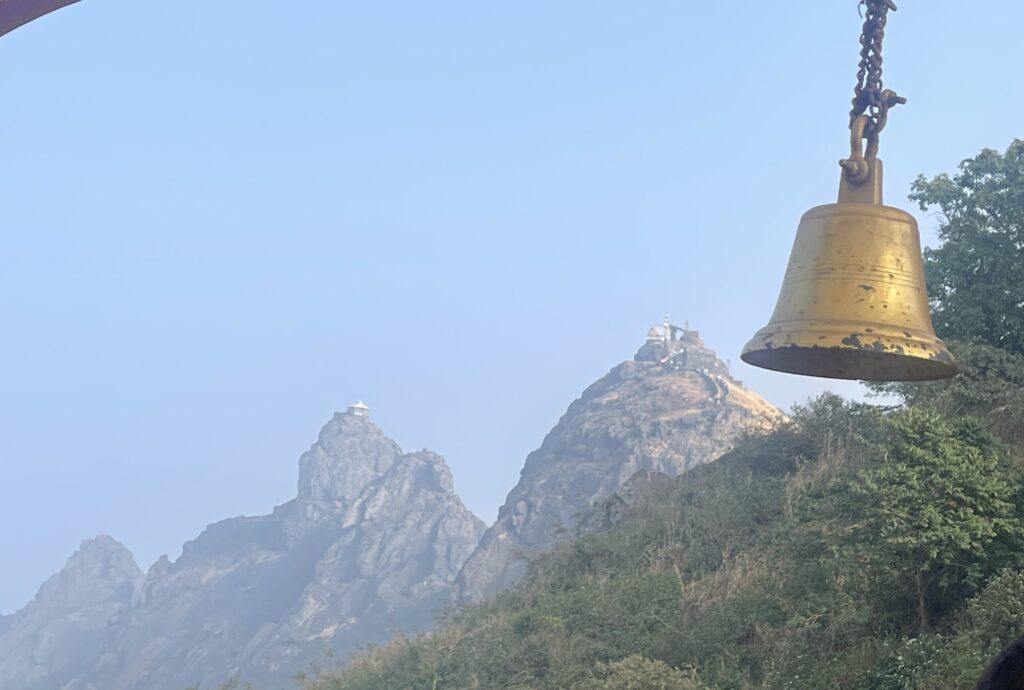
Once at the top, we climbed a few more steps to reach the Maa Amba Temple. The darshan here was absolutely blissful, especially after dreaming of this moment for so long.
From here, we trekked another 600 steps to visit the Baba Gorakhnath Temple. The views were breathtaking — panoramic hills, greenery, and a sense of spiritual calm that you can only experience in such sacred places.
The third and final peak leads to the Shri Guru Dattatreya Temple, another 1000 steps up. We were already quite tired — me and my daughter decided to stop, but my wife, ever the trekker in the family, was ready to keep going! 😄 We skipped going there for the next time.
We took the ropeway back down, cherishing every second of the descent and the magnificent views one last time.
🏨 Hotel Hunt, Highway Adventures & a Surprise
By now it was 5 PM, and we began looking for a hotel to stay in Junagadh. We found one within our budget, but something told us to push ahead to Rajkot.
We started from Junagarh to reach Rajkot for our stay, while driving on the highway, we accidentally missed the turn to Rajkot city and ended up going further along the main road. We weren’t finding good hotels, so we decided to continue driving a bit more.
Eventually, we stopped at a small highway town and — to our delight — found a good hotel within our budget. After freshening up, we enjoyed again a delicious Kathiyawadi dinner, came back to our room, and fell into a deep, satisfying sleep.
Little did we know, this place — seemingly just another stop on the map — was holding a surprise for us in the morning.
🛕 Day 9: Chotila Surprise – A Divine Turn We Didn’t Plan
We woke up the next morning, freshened up, and casually asked the hotel owner about the area. That’s when we found out—we were in Chotila, home to the famous Chamunda Mata Temple, situated on a hilltop with 1000 steps.
We were stunned! The temple was right in front of our hotel, and we hadn’t even realized it. The missed turn to Rajkot, the hotel hunt on the highway, and stopping here — it all made sense now. It was Maa Chamunda’s wish to give us darshan, and she made it happen in her own divine way. 🕉️
Without wasting another moment, we turned our ScorpioN toward the hill and began the 1000-step climb. It took us about 15-20 minutes, surrounded by scenic views and cool hill air.
✨ The Legend of Chamunda Mata
The Chotila Chamunda Temple, believed to have been built in the 12th century by the Solanki Dynasty, is steeped in legends. Chamunda Devi, a fierce form of Durga, is said to have slain the demons Chanda and Munda here, hence the name.

The temple radiates a powerful energy, and it’s a place where devotees seek strength, healing, and protection. Especially during Navratri, this place is packed with thousands of devotees, all drawn by the goddess’s grace.
After a soul-satisfying darshan, we descended with hearts full of gratitude and smiles on our faces. After coming down we enjoyed our breakfast of Fafda, Gathiya and Jalebi.
🌿 Hill Station Vibes – Destination Saputara
From here, we resumed our journey toward home. The route took us through Surat, Delhi-Mumbai Highway, and Samruddhi Mahamarg which is named on Hindu Hrudaysamrat Shri Balasaheb Thackray.
It was a long drive with tea and lunch breaks, and by nightfall, we finally reached Saputara, a charming hill station nestled in the Western Ghats. The cool air, lighted hills, and peaceful vibes were a welcome change.
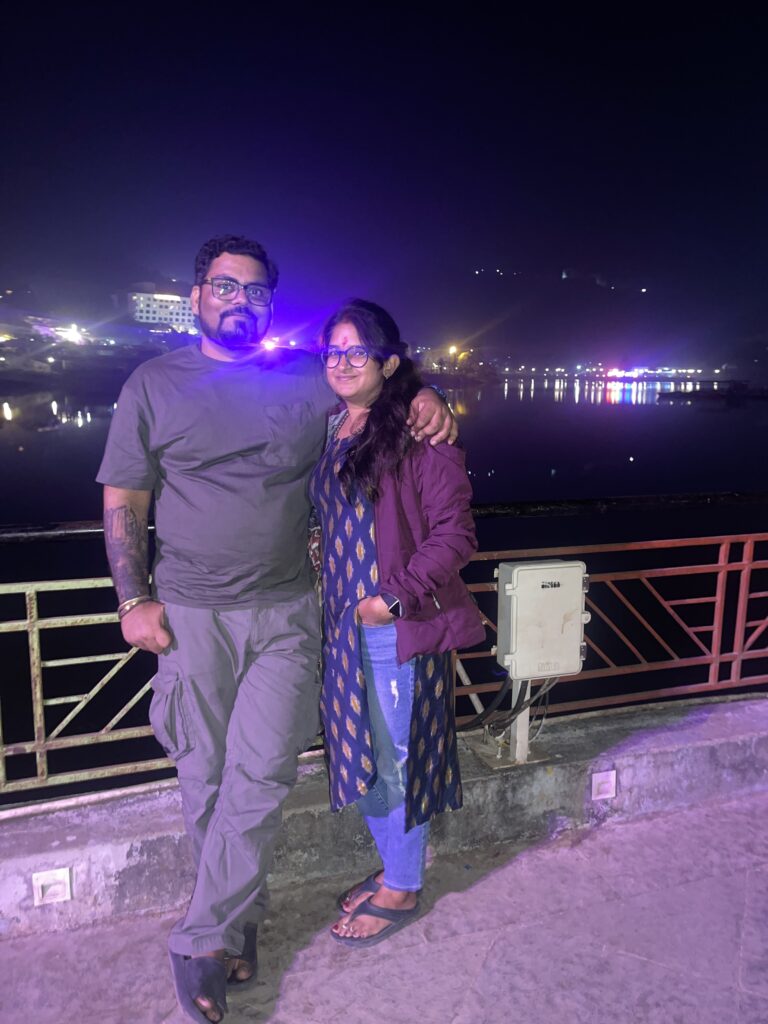
Like before, hotel availability was zero due to weekend. So, once again, we found a safe parking spot near the bus stand, grabbed dinner from a local restaurant, and decided to sleep in the car. We took a short walk outside, soaking in the chilly air and hilltop lights. Later, we returned to the car and tried to sleep.
🌙 A Strange Midnight Moment
Around midnight, the bus stand grew silent—everyone had left, and all shutters were down. While half-asleep, I suddenly heard faint sounds outside the car. I didn’t open my eyes but stayed alert. The noise faded… then returned.
With no one around, I decided to move the car to the food street, where stalls were still open and the area was buzzing. We parked there and finally got peaceful rest till 5 AM.
🌅 Day 10: The Final Drive – Wrapping Up a Divine Journey
I didn’t get much sleep that night, but by 5 AM, we were up and ready to hit the road one last time before reaching home. We filled up the ScorpioN with diesel and began our journey home, cruising gently through quiet villages still wrapped in early morning darkness.
Along the way, we came across several shops selling Pathini sarees, known for their traditional elegance. We stopped at one shop, hoping to pick up something memorable, but unfortunately, the collection wasn’t great, and other shops hadn’t opened yet. So, we decided to move on.
It was a long haul again, driving through Gujarat, Maharashtra, crossing into Telangana, and finally reaching home around midnight. Tired but fulfilled, we stopped for dinner at our go-to spot near home, soaking in the final moment of what had been an epic road trip.
🛣️ 10 Days, Thousands of Kilometers, Endless Blessings
This road trip was not just about covering distances—it was a journey of the soul. From the borders of Nadabet, ancient city of Dholavira to the white sands of Dhordo, the sacred temples of Dwarka and Somnath, the peaceful ghats, the sacred peaks of Girnar, to the serene hills of Saputara, every moment was a mix of fun, challenge, faith, and blessings.
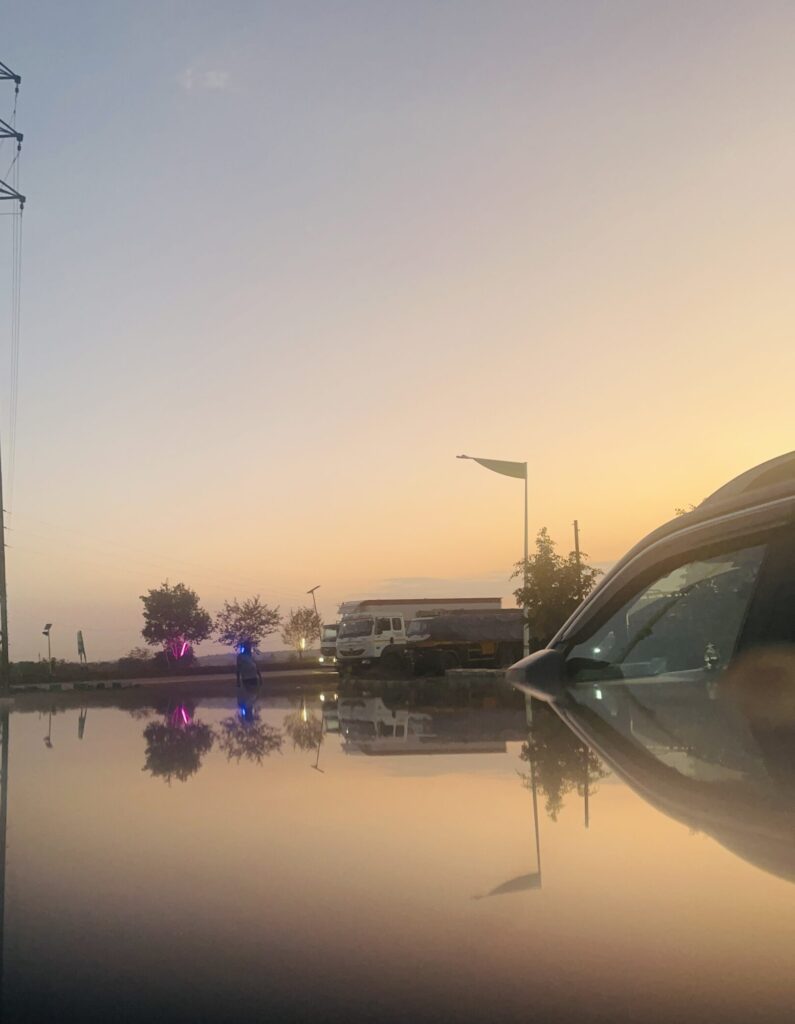
We navigated full hotels, cold nights in the car, divine interventions, spontaneous detours, and unforgettable darshans. The ScorpioN didn’t just carry us—it became part of the journey, part of the memories.
🌟 🚗🙏🏽 Final Thoughts
This wasn’t just a road trip—it was a time-traveling, soul-soothing, eye-opening journey across one of India’s most diverse states. From ancient ruins to spiritual highs, Gujarat gave us memories for a lifetime.
Here’s to more roads, more stories, and more divine adventures.
Jai Shri Krishna | Har Har Mahadev | Jai Mata Di 🙏
